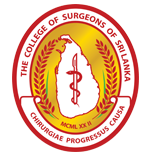Trauma Laparotomy; What trainee surgeons must know? A commentary
Trauma laparotomy is not an accelerated version of elective laparotomy
It always follows a set of well-rehearsed, sequential operative steps
These are
- gaining rapid access and exposure to abdominal cavity
- obtaining temporary bleeding control
- exploring abdominal cavity for injuries
and
- Decision making between Damage Control Surgery or Definitive Repair
Last step is the most important step to prevent patient going into the lethal triad of trauma; HYPOTHERMIA, ACIDOSIS, COAGULOPATHY
Therefore, this decision must be made early
Several factors are taken into consideration in making this crucial decision
These are
- How bad are the injuries?
- What is the trauma burden? (whether there is a concomitant chest, head, limb injuries)
- How experienced am I, in handling this situation?
- Am I supported with other facilities? (availability of blood, quality anesthetic support/ ICU)
- How stable is my patient?
Decent vital findings on the anesthetic screen like pulse, blood pressure and oxygen saturation should not give us relief, because there is always a possibility that the patient may have been hypotensive for some time before resuscitation
This means that SIRS may have already begun!
There are some ‘red flag findings’ that will warn us to decide on go for the Damage Control early
These are,
- swelling of the small bowel and wall oedema
- dusky colour of the small bowel serosa
- tissues cold to touch
- reduced or lack of mesenteric pulsations
- swollen abdominal wall
- oozing from cut surfaces
Of these we know that wall oedema and small bowel distension appear early and oozing from the incision is a late feature
Therefore, again, the key reason for this early decision; Damage control Vs Definitive repair
is that, one should never wait until the appearance of lethal triad; HYPOTHEMIA, ACIDOSIS, COAGULOPATHY sets in
Once it sets in, the battle is almost over.
Steps in a sequence worth remembering is as follows
Incision
Midline vertical incision, extending from xiphisternum to pubic symphysis
First stroke – Skin and subcutaneous tissue, skirting umbilicus
Second stroke – Incising Lenia Alba
Third stroke – Enter the peritoneal cavity at the point just above the umbilicus where there is
either no peritoneum or with a very thin peritoneum
Most surgeons break through this loose point with finger, lift the abdominal wall up with the non-dominant finger and use heavy scissors to open up and down and divide the ligament of Teres to facilitate access to liver
If rectus muscle is seen, it tells us that we are lateral and should go medial
When the access is rapid for obvious reasons, we must always be conscious of potential damage to under lying structures
During upper part of the incision, left lobe of the liver, middle part, small bowel, lower part, bladder are the organs which are at risk
If the patient has had previous abdominal surgery, surgeons commence the incision from a virgin territory
If the previous incision is a lower abdominal mid-line incision, most would commence from the upper abdominal part of the mid-line incision, open the peritoneal cavity and continue under direct vision, separating small bowel adhesions to complete the lower abdominal part of the incision
In an abdomen with previous incisions, another alternative is to gain access with bilateral subcostal incisions joining in the centre, also called Roof top incision.
This is because, lateral aspect of the abdomen does not have adhesions as small bowel is mostly in the central part. Although with this incision, it takes time to gain access, time gained from speedy release of adhesions under direct vision will shorten the time taken for aveceration of the small bowel
Upon entry into the abdomen, it is most likely to see loops of small bowel ‘swimming’ in a pool of blood, possibly mixed with small bowel juice, faces, urine and/or bile
To gain further access, the next step in the sequence is to deliver all the small bowel out of the peritoneal cavity
This step is, called, AVECERATION OF THE SMALL BOWEL
This is followed by quick suction of fluid
This provides a reasonably manageable temporary workspace for us to proceed
The next step is EMPARICAL PACKING to obtain temporary bleeding control
This must be done rapidly, packing one quadrant at a time while the assistant is retracting the quadrant with a wide retractor
Packs should not be inserted before aveceration. It is not effective
Method of packing
Although there are individual preferences, most would commence from right upper quadrant
Hand is then placed over the right lobe, dome of the liver is pulled downwards and large towel packsare placed over the hand filling the space between right hemi diaphragm, right lobe and the anterior abdominal wall above and below the liver
A the hand is over the liver, tactile assessment made to feel for possible injury
Then, placing packs is continued to fill the right paracolic gutter
On the left upper quadrant, surgeon will place the non-dominant hand over the spleen, gently pull the spleen downwards and place packs over the hand first and then between the left lobe and left hemi diaphragm, while feeling for injuries
The purpose here is to create a sandwich by placing packs medial and posterior to the spleen and by placing packs in the left paracolic gutter
Lastly, we will pack the pelvis
At this stage, best not attend to injuries, unless there is massive bleeding.
Our objective at this stage is to achieve temporary bleeding control
The next step is to avecerate the small bowel
If blood is seen leaking around the packs at this stage, most likely, source is a mesenteric bleed
This is best attended at this stage as we have already obtained a temporary working space
We will use digital compression, using two fingers to the base of mesentery to gain initial control
Remember that veins bleed from both sides
Therefore most surgeons would transfer the digital compression a competent assistant to free hands
Using 5.0 prolene, we can control bleeding at this stage
An alternate way of compression is to use sponge holding forceps without the sponge
Empharical packing will not arrest major haemorrhage
It only gives us, little time to organize our effort
Another time-tested rule is that, in a penetrating trauma, for example in a stab injury, where the trajectory of (direction of penetration) can be worked out, once we get the workspace after aveceration, it is a good idea to go direct to the bleeder
If it is a solid organ like liver, there are two ways of packing
One is sandwich packing, that is, compressing the injury from above and below as described earlier and other is, packing the injured cavity with absorptive gauze.
I will unfold the gauze roll and push against the wall of the injured parenchyma
Some surgeons do sandwich after packing within, depending on the situation
If we fail to achieve decent haemostasis with packing, then obviously it is a damage control situation, and we will have to make that decision at this stage
What are our choices at this stage?
Remove and repack / use haemostatic agents and re pack. Figure of eight suture may help; more than 2 or 3 may be needed. If there is a major arterial injury, we may have to deal direct
Last resort is aortic clamping. It is easier said than done
We must not do this reflexly with a blind clamp
It is going to fail
Technique is, pull the stomach downwards, make an opening in the avascular portion of the lesser curve, first apply digital compression, then dissect higher up in the para aortic area and apply the clamp
EXPLORATION
Once surgeon obtain a temporary control, next step is to rapidly explore the abdomen
Abdomen has supra and infra-colic compartments
Infra-colic compartment has small bowel, colon, bladder and reproductive organs
Surgeon will lift the transverse colon superiorly and will start inspecting small bowel from ligament of Treitz to rectum
When checking small bowel, special attention must be paid to mesenteric border
Another trick of the trade is, if it is a gun-shot injury with entry and exit wounds, most surgeons would count the number of holes in the small- bowel. It is must be an even number. If it is an odd number, it is possible that we may have missed an injury
in the colon, hepatic and splenic flexures and posterior aspect of the transverse colon are the areas notorious for ‘missing injuries
Unlike small bowel injuries, we may be able to ‘smell’ the colonic injury
Most surgeons will try not to create stomas with small bowel injuries or even with large bowel unless it is an extra peritoneal rectal injury
Options are, one-layer closure, or multiple staples to even to occlude the leak to be attended to later
If the patient is unstable, most surgeons will not waste time to divide mesentery with the segment of small bowel
Only control of bleeding is sufficient, if the patient is unstable
If bowel injury is noted, it must be clamped immediately to stop further spillage
There are 5 locations of the bowel where injuries may be missed.
These sites are,
- Oesophago-gastric junction
- Proximal small bowel around Ligament of Treitz
- Mesenteric border of the small bowel
- Posterior wall of the large bowel
- Extra peritoneal rectum
Bladder injuries do not bleed profusely unless it is deep and at the bladder neck. Once it is recognised, it is usually attended with one layer of continuous suture and if the patient is unstable, with other major injuries, pelvis is simply packed and a catheter is positioned
Supra-colic compartment is the next
Here the technique is, pull the stomach down, inspect both curves of the stomach and, if an injury is suspected in the duodenum, kocherize the duodenum
Dividing the ligament of Treitz and left triangular ligament helps to mobilize liver
Spleen and both hemi diaphragms must be assessed
Exploring the retroperitoneum is a tricky procedure
The point to remember is that, expanding retroperitoneal haematoma has already done the retroperitoneal dissection and the principle will must remember is to medially rotate the intra peritoneal organs during this approach
Whether are are going to do a left sided or right sided exploration will depend on the suspicion of the organ that is likely to be bleeding and the trajectory of the knife or the bullet
Left sided medial visceral rotation is also called MATTOX manure
The most difficult site to access in the retroperitoneum is the mid-line supra-colic compartment where there is supra renal aorta and its branches
We cannot access this site from the front because of the stomach and pancreas
The technique is to divide the peritoneum in the left paracolic gutter like mobilizing the left colon for colectomy extending the incision above the splenic flexure
We will continue extending the incision lateral to spleen
This will help me to medially rotate spleen, left kidney and pancreas
This will help us to be ‘right on the posterior abdominal wall’, to take care of bleeding
This might be easier than you think because, retroperitoneal haematoma has done most of the dissection
We can continue extending the incision superiorly up to left crus of the diaphragm divide it laterally, if I need to dissect around aorta
This is another way to obtain access to aorta for clamping
This exposure helps to gain access coeliac axis, superior mesenteric, left renal and left iliac arteries
According to experts, a point to remembering is that, when we do this for the first time and the aorta is clamped it becomes like a pulseless flaccid tube which makes it be difficult to identify in the middle of a haematoma
The advice therefore is, to explore and define infra renal para aortic plane before the supra renal aortic clamp
Another important point is the risk of injury to the left lumbar vein at this stage
This vein arises from the left renal vein and crosses the aorta just below the left renal artery Evulsion may cause problems. Better to ligate and divide
Right sided Medial Rotation has three stages
First stage is the Kocher mannure, where we commence mobilizing the peritoneum lateral to duodenum like for a Whipples operation
Identify the duodenum, divide the peritoneum lateral to it, extend the incision superiorly and inferiorly from bile duct to hepatic flexure, lift the duodenum together with the head of the pancreas till we gain access to superior mesenteric vein and portal vein
Again, this may be easier than the dissection for Whipples, because, haematoma has done the dissection
Then, we will lift the head of the pancreas to gain access to IVC
We must be careful of the right gonadal vain which comes directly from IVC. In fact, the access become easier when we commence second stage, the next stage
Second stage is the extended Kocher maneuver, where we continue the peritoneal incision in the right paracolic gutter like for a right hemi colectomy
This technique, supported by the expanding haematoma, we will gain access to full length of IVC, right kidney renal hilum and right iliac vessels with some ease
Third stage is the CATTELL-BRAASCH Maneuvre
The key anatomical point is that mesenteric vessels arise from the posterior abdominal wall in a line extending obliquely from caecum to ligament of Treitz
We are now aware that this length is shorter than the impression we got from anatomy text-books long time ago!
The way to do this is to curve my peritoneal incision around the caecum, while lifting small bowel in a cranial direction and continue dividing the line of fusion in the posterior peritoneum up to ligament of Treitz till you are in a position to place the entire small bowel on the chest wall
This will provide us with a panoramic view of the posterior abdominal wall
We must be conscious of the risk of avulsing the superior mesenteric vein which is at the root of the mesentery
Abdominal wall closure
In Trauma Laparotomy performed as part of Damage control Surgery, we must take all the measures to prevent Abdominal Compartment Syndrome that can kill the patient
In simple terms it is best not to close the abdomen using a traditional closing method
Principle is to allow space for the bowel to distend post operatively, while containing and protecting bowel from getting exposed to exterior
One can invent several methods to achieve this principle. In Sri Lanka most surgeons use the urinary bag and suture to wound edges to protect bowel getting exposed
Lastly, all experienced trauma surgeons would tell you that it is a cardinal sin to close the abdominal wall under tension following g Trauma Laparotomy




